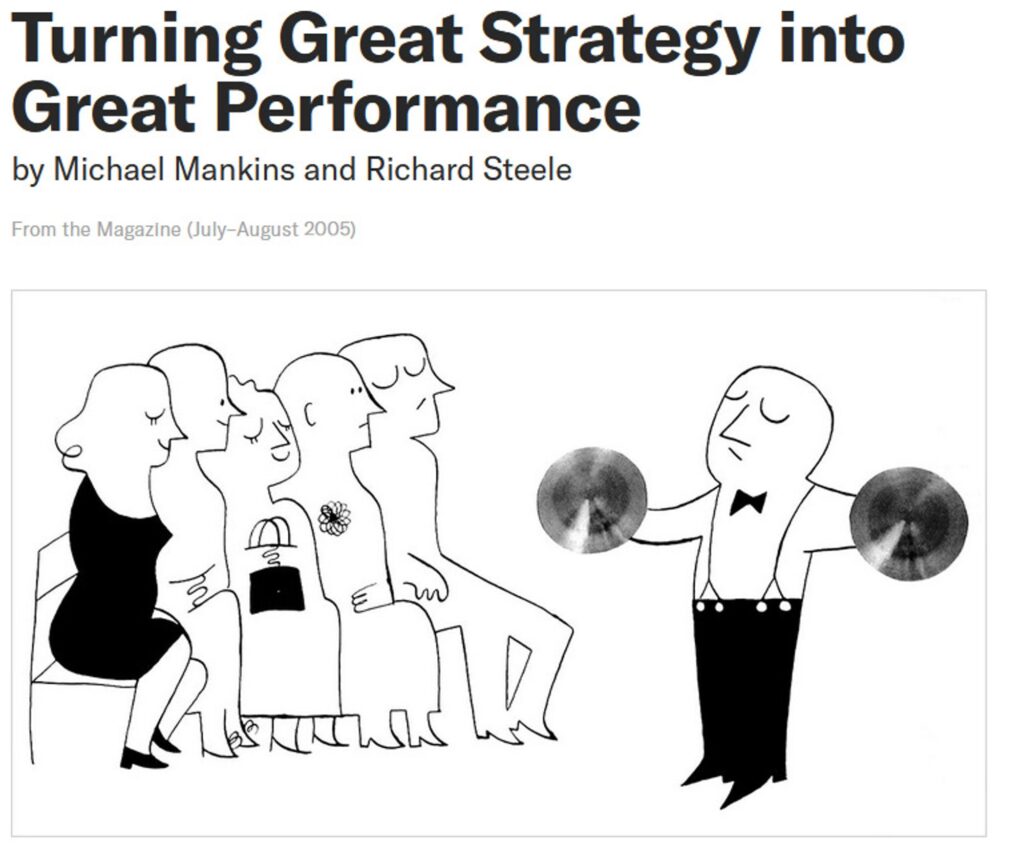
We all seem to understand that bad execution taxes the business, literally and figuratively. But do you know by how much? A twenty-year-old article in the Harvard Business Review estimates that poor execution leads to underperformance of between 60-100%, and this is just the direct impact! In the long term, it creates a permanent and devastating culture of poor performance. Though this article focuses on large companies, growth-stage founders can learn from these findings to improve their own company’s performance.
Summary
Goals
- Share the direct and indirect costs of avoidable gaps between strategy and performance
- Identify solutions to mitigate the “strategy-to-performance gap”
Key Points
- A 2005 study of larger businesses (>$500 million) estimates that companies regular fall short on strategic initiatives because of manageable execution problems, which, if solved, would improve performance by a whopping 60-100%.
- The gap between strategy and performance is a function of multiple failures that are common across businesses and geographies. These include failure to measure and track performance, poor communication of strategy, inadequate resourcing, and lack of visibility on operational bottlenecks.
- Smaller businesses (startups and growth-stage companies) are not exempt from these challenges. While they face fewer coordination problems, their leaders often lack experience. Moreover, their businesses may be operating at speeds and maturity levels where doing feels more important than planning and measurement.
- Solutions to these failures include keeping strategy simple and concrete, being disciplined about metrics and monitoring, being clear about priorities, and ensuring communication up and down the organization.
- Failure to address execution problems creates a culture of low performance characterized by the expectation that plans will fall short.
I read a lot of articles about leadership and execution. Every once in a while I come across one that reminds us the very steep price we pay when we execute poorly.
This seminal article from the July 2005 issue of Harvard Business Review, entitled “Turning Great Strategy into Great Performance”, aims to quantify the gap between strategy and performance. What I like about this article, and what sets it apart, is its broad approach. For while the existing literature offers numerous case studies spotlighting individual challenges, this article is the only one I’ve found that systematically explores execution across varied industries and regions. The authors not only pinpoint universally applicable causes but also assign hard numbers to the cost of poor execution.
The money shot from the article is this.
The prize for closing the strategy-to-performance gap is huge—an increase in performance of anywhere from 60% to 100% for most companies. But this almost certainly understates the true benefits. Companies that create tight links between their strategies, their plans, and, ultimately, their performance often experience a cultural multiplier effect. Over time, as they turn their strategies into great performance, leaders in these organizations become much more confident in their own capabilities and much more willing to make the stretch commitments that inspire and transform companies.
(emphasis added)
I think most leaders intellectually understand that execution is important. But sometimes it takes data, like a cold shower, to wake us up and say “I really need to do something about this”. And if that 60-100% figure doesn’t light a fire in your belly, maybe this will.
In many companies, planning and execution breakdowns are reinforced—even magnified—by an insidious shift in culture. In our experience, this change occurs subtly but quickly, and once it has taken root it is very hard to reverse. First, unrealistic plans create the expectation throughout the organization that plans simply will not be fulfilled. Then, as the expectation becomes experience, it becomes the norm that performance commitments won’t be kept. So commitments cease to be binding promises with real consequences. Rather than stretching to ensure that commitments are kept, managers, expecting failure, seek to protect themselves from the eventual fallout. They spend time covering their tracks rather than identifying actions to enhance performance. The organization becomes less self-critical and less intellectually honest about its shortcomings. Consequently, it loses its capacity to perform.
(emphasis again added)
Wow.
You would think that given the glaring benefits of effective strategy implementation, companies would develop the competency to do it well. This turns out not to be the case. The following paragraph was particularly eye-opening:
Virtually all of [the businesses we studied, across industries and geographies,] struggle to produce the financial performance forecasts in their long-range plans. Furthermore, the processes they use to develop plans and monitor performance make it difficult to discern whether the strategy-to-performance gap stems from poor planning, poor execution, both, or neither.
- Companies rarely track performance against long-term plans.
- Multiyear results rarely meet projections.
- Most of the value is lost in translation.
- Performance bottlenecks are often invisible to management.
- Over the long term, failure to execute creates “a culture of underperformance”.
The authors offer the following advice:
- Keep the strategy simple so that action can be concrete
- Debate assumptions, not forecasts
- Use a rigorous framework for analysis, with common terms that everyone understands
- Discuss resources early on
- Be crystal clear about priorities
- Continuously monitor performance
- Reward and develop execution capabilities
To be sure, these are excellent recommendations, and are consistent with how I advise my clients as well. There is more in the article in terms of what these challenges feel like for executives that is interesting, but not critical in terms of reading. What’s important is understanding the size of the prize.
Insights for smaller companies
The data in this article comes from a survey of senior executives from 197 companies worldwide with sales exceeding $500 million. These are obviously large companies whose workforces surely number in the thousands. How relevant are the findings for smaller companies, though? Very relevant, actually. Though smaller companies—whether they have $10 million or $100 million in sales—have inherently different advantages and challenges, there is plenty they can learn from this study.
The good news for smaller companies is that, simply because they are smaller, they don’t face the severe coordination problems their larger counterparts do. Strategy by its nature requires broad alignment across a business. As the authors of this article illustrate, that is easier said than done. Startups and scaleups have the advantage of working in tighter teams where regular contact is the rule. If the founders and leadership team are focused, fewer gears need to turn to get the company to move.
Unfortunately, that’s generally where the advantages end. Smaller companies tend to face two significant impediments to disciplined strategy implementation.
Lack of experience
Developing and implementing strategy—particularly strategy that is transformational—is not an everyday experience. Even under ideal circumstances, operating under uncertainty, building and transforming teams, making the right investments in the right people at the right time (especially when funds are limited) is challenging. Many founders and senior leaders don’t have this experience.
Speed, size, and maturity of the business
In any business, people tend to gravitate toward doing rather than planning. The urgency of daily work is more concrete and ever-present. This is especially true for smaller, rapidly scaling businesses. In this context, the formality of planning and goal setting and the discipline of tracking business KPIs can feel like an extravagance. Even founders and leaders who know they should be doing it (and most I work know they should) tend to devote insufficient time to it.
Yet at some point the business must mature. Small businesses are like teenagers: they need constant feeding, they are easily distracted, and they don’t always respond in predictable ways or make wise choices. Getting past this “adolescent” phase, as I regularly tell my clients, means that founders and leaders need to start working ON the business as opposed to IN the business. It is simply impossible to efficiently scale a business without doing this, especially if you are aiming for an exit.
Mind the gap, and get help
Recognizing that there is strategy-performance gap is the first step to addressing it. Fortunately, in smaller companies, poor execution is pretty easy to spot, even if you don’t have metrics.
- Missed deadlines: Consistently failing to meet goals and/or deadlines
- Unsatisfying financial performance: Revenues not growing as expected (or worse, stagnant or declining) or costs that rise in proportion with revenue (or worse, costs increasing faster than revenue)
- The cash burn that won’t stop burning: Seriously, at some point you need to turn a profit
- Declining employee morale: Flagging motivation, bickering, burnout, turnover… you’ll know this is happening
- Customer challenges: Fewer orders, declining customer satisfaction
- Harder to get things done: Operating the business is increasingly difficult, and the only solution seems to be adding more people
- Your own personal burnout: Does it feel like the business simply won’t run without your personal involvement?
By virtue of their size, smaller companies can’t call on internal resources to help out. Founders then must rely on their investors’ experience, find other advisors, or self-educate through publicly available resources (like articles on this website).
Having the right people makes a big difference
I will leave you with one final quote from this article that really struck a chord given my views about the importance of great managers.
No process can be better than the people who have to make it work. Unsurprisingly, therefore, nearly all the companies we studied insisted that the selection and development of management was an essential ingredient in their [long-term] success.
For Barclays’ Bob Diamond, nothing is more important than “ensuring that [the company] hires only A players.” In his view, “the hidden costs of bad hiring decisions are enormous, so despite the fact that we are doubling in size, we insist that as a top team we take responsibility for all hiring... We vet each others’ potential hires and challenge each other to keep raising the bar.”
Conclusion
If executing well can potentially double growth in large companies, there is every reason to believe the same is possible in smaller ones. The prize is at least as great, and the cost of poor execution is even steeper. I will write more about how founders can overcome challenges to execution, like planning under conditions of uncertainty, gaining alignment with the team, setting the right goals and measuring performance, and more. But I can’t emphasize enough how important it is to face up to them. While early investors may be enamored by a company’s vision, subsequent ones seek tangible evidence of a well-oiled machinery that seamlessly transforms ideas into actions. The better that machine performs, the better the exit.

